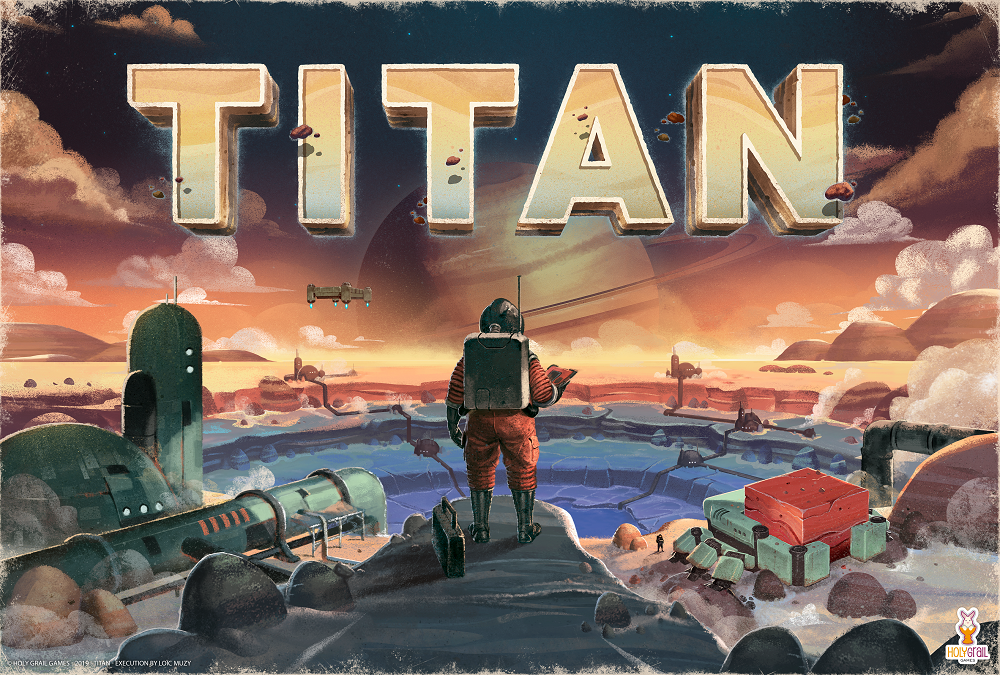Kickstart This! #130: Titan

Designer: Mathieu Podevin
Artist: Loic Muzy (Cutthroat Caverns, Fireteams Zero, Mythic Battles: Pantheon, Rallyman GT)
Publisher: Holy Grail Games (Museum, Rallyman GT, Rising 5: Runes of Asteros)
Genre/Mechanisms: network and route building, take that, territory building, worker placement
Funding Status: At the time of this posting, Titan is already fully-funded. In fact, pledges currently total 4x the initial funding goal with 3 days left to go on the campaign.
Player Count: 2-4
Solo Mode: no
Complexity: heavy
Risk: medium-high
What It’s About: Players compete to strip-mine the planet of Titan using a ship full of Rigs, Pipes, and Drones in this worker placement game featuring a three-dimensional board.
How It Works: In Titan, gameplay takes place over 5 rounds, or cycles, each made up of 4 turns for each player. The game begins with a Landing Phase, in which players place their first Base and 3 surrounding Pipes, acquire their first Rig, and place an Ice tile. Then the first cycle begins. At the start of each cycle, players first Prepare and Deploy Rigs. Then players begin the turn cycle, beginning with the first player and proceeding clockwise. On their turn, players choose an action available in their dropship.
When Expanding their Network, players take a Pipe from their Dropship and place it onto the board. If it’s placed into a spot with a resource, they collect that resource. If it connects a Rig back to their Base, they collect the Resource associated with that Rig. If it connects Titan’s Core to their Base, they’ll start exploiting Titan’s rich Deuterium reserves.
When Recovering Resources, players take a Resource from their Dropship and place it into their Cargo Hold.
Players can also take Free Actions on their turn, including 1) Activating a Drone, 2) Fulfilling a Planetary Order or Completing a Corporate Objective, and 3) Upgrading a Rig. These Free Actions can be taken after the player’s mandatory action, but must be taken in the listed order. Each player has 4 Drones that activate once each per cycle, performing a variety of actions like increasing Rig output, collecting Deuterium or Tholin cubes, or reducing the cost of upgrading Rigs & destroying pipework.
When a Drone is Activated, it first Moves from one Rig to another Rig, and can then perform an action Loading Resources, either picking up or dropping off. Drones Dock as an automatic action when empty and ending its movement next to a Rig. Fulfilling a Planetary Objective involves exchanging Resources to score the Credits on the Objective Card. Completing a Corporate Objective, on the other hand, doesn’t require the player to discard the resources, simply to have them in order to score the associated Credits. And finally, Upgrading a Rig can be performed on a Rig either connected to the active player’s Base via their pipe network, or on a Rig where the active player has a Drone present. The player pays the associated cost, and then receives additional resources each time the Rig is activated in the future.
At the end of each Cycle, players trigger the Extraction Phase, gaining resources each place they have a Control Token. The first player token then passes to the left and the next Cycle begins. At the end of the fifth and final Cycle, players perform the last Extraction Phase, and then proceed to end game scoring. Each player gains 2 Credits for each Deuterium in their Hold and loses 1 Credit for each Tholin in their Hold. Players then compare their stocks of Silicium, Hydrocarbons, Water, Titanium, and Fulfilled Planetary Orders. The player with the most of each receives 3 Credits and the player with the second-most of each receives 1 Credit. And then the player with the most total Credits is declared Star Employee and wins the game. Ties are broken by the player with the least remaining Pipes in their Hold, and then by the player who controls the most Rigs.
Comparisons: At its heart, Titan is a resource management and network building game, with a variety of mechanisms that offer several different ways to score points, ultimately resulting in a kind of efficiency puzzle. It bears much in common with a variety of games, from Age of Steam and Railways of the World to Brass: Birmingham and Brass: Lancashire to Gaia Project and Terra Mystica. Keyflower, Myrmes, and Underwatercities are examples of some popular and well-rated games that also combine network building with worker placement.
What Should I Pledge?:
$91 Miner: the core box, Kickstarter Edition.
$139 Foreman: the Miner pledge plus The E-Team Expansion (5th Player), Starbot Expansion, It Came From Below! Expansion, and For Science! Expansion.
Add-Ons:
$47 All-In Pack with all 4 Expansions, for Early Bird Backers only.
$9 Starbot Expansion
$13 The E-Team Expansion (5th Player)
$20 It Came From Below! Expansion
$13 For Science! Expansion
KS Exclusives:
The KS content currently includes: 8 additional Operator tiles, 8 Drones Objectives and Special Board, 8 additional Planetary Orders, Game Soundtrack, Resource Storage Boxes, and Metallic Effect for the Tholin, Silicium, and Titanium cubes.
All-In Total: In the continental U.S., you’re looking at $139 for the Foreman Pledged an estimated $20 in shipping for a total of $159.
Titan completes its Kickstarter on Tuesday, November 19th and tentatively ships in November 2020.